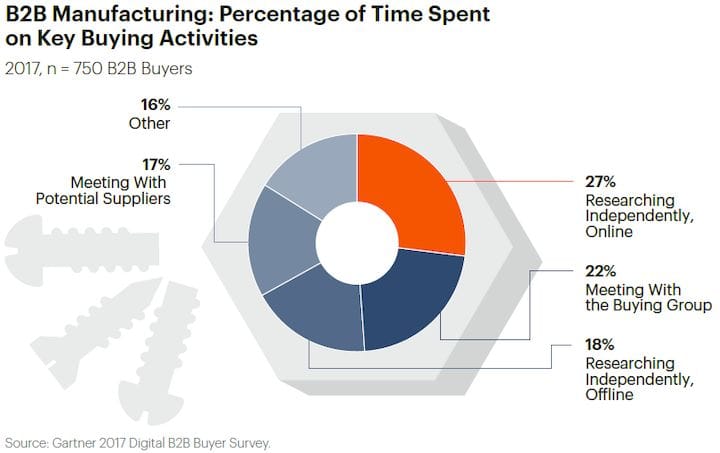![Buyers of technology have shifted their approach [Source: Gartner]](https://fabbaloo.com/wp-content/uploads/2020/05/image-asset_img_5eb09900c55ab.jpg)
A post from our friend Pete Basiliere of Gartner analyzes the digital capability of 3D printer manufacturers.
If you’re not familiar with Gartner, they are a massive service company that provides technology analysis to businesses. They employ squads of experts dedicated to numerous technology domains, who look deeply into the current state of affairs. They then analyze and relay this information to Gartner clients.
While Basiliere focuses on 3D printing primarily, he also has access to all the other experts at Gartner in all the other fields. One of the domains followed by Gartner experts are trends in technology buying practices.
One of the recent trends these analysts have observed is this significant tip towards independent research by buyers before purchase. And of course, much of this research is done online.
This is a big switch from the historical pattern of sales being primarily delivered through physical meetings with the supplier directly or the supplier’s of sales staff. Thus Gartner believes the importance of digitally marketing has significantly increased. As the future unfolds, it’s likely this effect will increase.
Basiliere took this finding and applied it to the 3D printer manufacturing space. He used a Gartner analysis tool to measure what they call the “Digital IQ Index”, which involves specific metrics around accessibility, web development practices, and SEO.
![Measuring the web effectiveness of several leading 3D printer companies [Source: Gartner]](https://fabbaloo.com/wp-content/uploads/2020/05/image-asset_img_5eb0990122169.jpg)
He measured seven of the leading, and coincidentally largest, 3D printer manufacturing companies against this scale. He found that in almost all measurement factors, the 3D printer manufacturers fell below — and sometimes far below — the averages of the top brands in all industry measured with this tool.
Basiliere says:
“The trends discerned by Gartner L2 don’t diminish the high-touch role of sales in consummating an enterprise 3D printer purchase. Rather, the trends dictate a change in the marketing playbook that elevates the customer’s buying experience in a manner that leverages digital to support new and existing sales opportunities.
With few exceptions, these 3D printer manufacturers must improve elements of their online discoverability and website ease of use.“
We strongly agree with this assessment, but we would add a bit more perspective, as this publication has often worked directly with 3D manufacturers on marketing matters. Many of the companies we work with are actually far smaller then those measured by Basiliere.
In our experience it is actually quite rare to find a new, small 3D printer manufacturing company with advanced marketing mojo. In most cases, companies are dominated by technical concerns, and marketing matters seem to be an afterthought.
I believe this phenomenon is a great detriment to the success of these small 3D printer manufacturers, many of whom genuinely offer innovative and sometimes quite amazing 3D printing products. I can say that many times at 3D printing tradeshows we’ve bumped into companies with technologies far in advance of those companies with more marketing dollars.
Many times I’ve thought “What kind of marketing campaign would [big 3D printer manufacturer] create if they had come upon this innovation instead?”
Often this puts into perspective the sometimes meager technological advances made by some of the big companies that are usually played out through significant marketing campaigns.
For me the bottom line here is two things:
First, 3D printer manufacturers large and small must get their act together on marketing in today’s digital world. In many cases companies simply will not have the expertise to do so in-house and they should consider outsourcing some of this work to professionals dedicated to business in that domain.
Secondly, 3D print buyers must put on some x-ray glasses to see through marketing campaigns and determine what’s really going on. They should also cast their buying net wider to enable discovery of poorly marketed, but still highly useful solutions.
Via Gartner











No one seems to offer collaborative 3D printing modes on dual extrusion devices. We explain why this is the case.